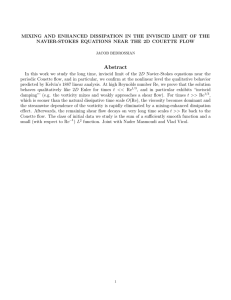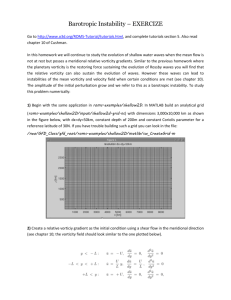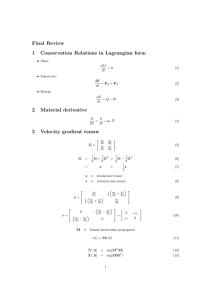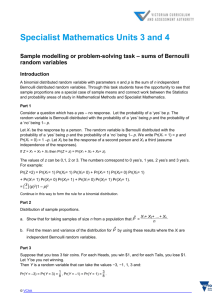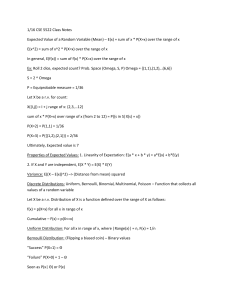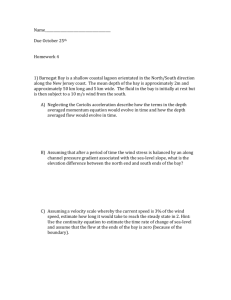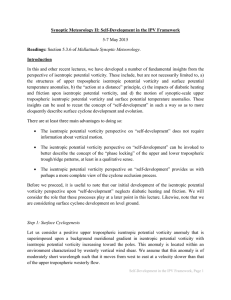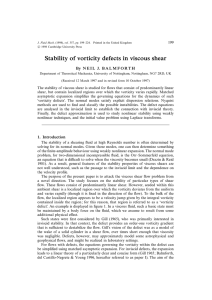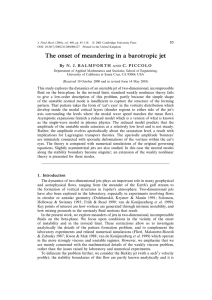CHAPTER 11 The Bernoulli Equation & Crocco's Theorem We start
advertisement
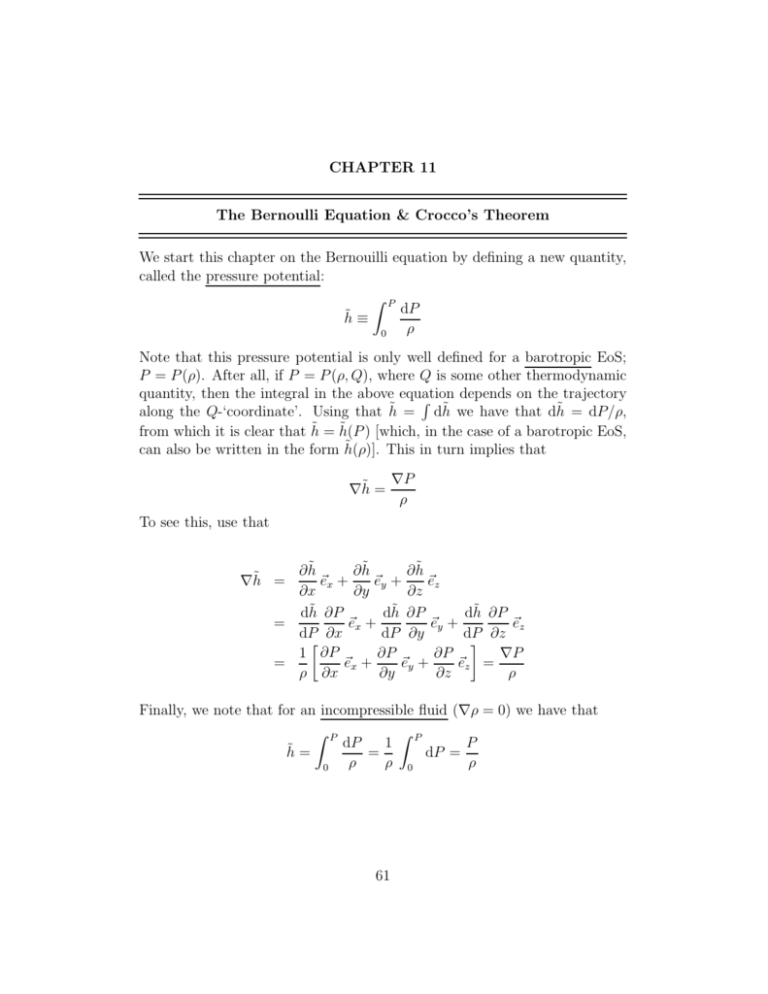
CHAPTER 11 The Bernoulli Equation & Crocco’s Theorem We start this chapter on the Bernouilli equation by defining a new quantity, called the pressure potential: Z P dP h̃ ≡ ρ 0 Note that this pressure potential is only well defined for a barotropic EoS; P = P (ρ). After all, if P = P (ρ, Q), where Q is some other thermodynamic quantity, then the integral in the above equation depends on the trajectory R along the Q-‘coordinate’. Using that h̃ = dh̃ we have that dh̃ = dP/ρ, from which it is clear that h̃ = h̃(P ) [which, in the case of a barotropic EoS, can also be written in the form h̃(ρ)]. This in turn implies that ∇h̃ = ∇P ρ To see this, use that ∂ h̃ ∂ h̃ ∂ h̃ ~ex + ~ey + ~ez ∂x ∂y ∂z dh̃ ∂P dh̃ ∂P dh̃ ∂P = ~ex + ~ey + ~ez dP ∂x dP ∂y dP ∂z 1 ∂P ∂P ∂P ∇P = ~ex + ~ey + ~ez = ρ ∂x ∂y ∂z ρ ∇h̃ = Finally, we note that for an incompressible fluid (∇ρ = 0) we have that Z Z P 1 P P dP = dP = h̃ = ρ ρ 0 ρ 0 61 Enthalphy: The enthalpy, H, is a measure for the total energy of a thermodynamic system, which includes the internal energy, U, and the amount of energy required to make room for it by displacing its environment and establishing its volume and pressure: H = U + PV The associated specific enthalpy is given by h≡ P H =ε+ m ρ with ε the specific energy. The differential of the enthalpy can be written as dH = T dS + V dP where we have used that dU = dQ + dW = T dS − P dV . Hence, for the specific enthalphy, h, we have that dh = T ds + dP ρ where s ≡ S/m is the specific entropy. We thus see that dh = dh̃ + T ds Hence, for an isentropic flow (ds = 0), we have that the pressure potential is equal to the specific enthalpy up to an integration constant. Intermezzo: isentropic vs. adiabatic According to second law of thermodynamics: T dS ≥ dQ. The equality only holds for a reversible process. dS = 0 ⇒ isentropic dQ = 0 ⇒ adiabatic Note that a reversible isentropic process is adiabatic. An irreversible, adiabatic process, however, can still create entropy. 62 Consider our momentum equations (ignoring bulk viscosity) ∂~u ∇P 1 2 + (~u · ∇)~u = − − ∇Φ + ν ∇ ~u + ∇(∇ · ~u) ∂t ρ 3 Now consider a steady, inviscid flow. Steady implies that ∂(everything)/∂t = 0, while inviscid implies that ν = 0. The latter implies that there is no friction, and hence no energy dissipation within the fluid. In the absence of radiative processes, this implies that the flow is isentropic (i.e., ds = 0). For our steady, inviscid fluid, the above momentum equations reduce to (~u · ∇)~u = − ∇P − ∇Φ = −∇(h̃ + Φ) ρ Now we use the vector identity 2 2 u u + (∇ × ~u) × ~u = ∇ +w ~ × ~u (~u · ∇)~u = ∇ 2 2 to rewrite the momentum equations as u2 + Φ + h̃ ≡ ∇B ~u × w ~ =∇ 2 where we have introduced Bernoulli constant B = 12 u2 + Φ + h̃. This is sometimes called Crocco’s equation, and shows that in a steady, inviscid, irrotational flow (i.e., no vorticity), there are no spatial gradients in Bernoulli’s constant (∇B = 0). This also implies that any mechanism that can create gradients in B, can create vorticity. Note that in astrophysics one rarely has solid boundaries, which can create vorticity in their boundary layers due to viscosity. As we have seen in the previous chapter, the only way to create vorticity in the absence of viscosity is via the baroclinic process. This suggest that one can not create vorticity in an inviscid, barotropic fluid. However, vorticity can be created in such fluids when they pass a curved shock. This is known as Crocco’s theorem. A fluid with ∇B = 0 that passes through a curved shock, typically will have a non-zero gradient in Bernoulli’s constant downstream from the shock, indicating that passing a curved shock can create vorticity. This is one of the main mechanisms in astrophysics for creating (large-scale) vorticity. 63 Taking the dot-product with ~u on both sides of the above equation, and using that ~u · (~u × w) ~ = 0, which follows from the fact that the cross product between two vectors is perpendicular to both vectors, we obtain the Bernoulli equation: ~u · ∇B = 0 which states that the gradients in B are perpendicular to ~u. Hence, B is conserved along streamlines. And since we made the assumption of a steady flow, B will also be conserved along particle paths. Note that B is a kind of energy measure: u2 /2 represents R kinetic energy, Φ represents the gravitational potential energy, and h̃ = dP/ρ is a measure for the energy stored in the pressure (i.e., in the form of the random motions of the particles). The Bernoulli equation states that in a steady, inviscid flow, the ‘energy’ B is conserved along streamlines (particle paths). However, along those streamlines ordered motion (~u) can be converted into random motion (P ), and vice versa. Kinetic energy can also be converted into potential energy, and vice versa. Applications of Bernoulli’s equation discussed in class are the shower curtain which moves inwards when the shower is on, and the lift experienced by an airplane wing (but be aware of the Equal Transit Time Fallacy). Another application is the venturi meter (see problem set 4). 64
